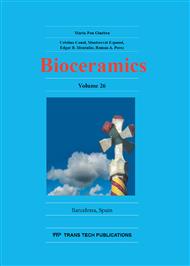[1]
H. Monma, T. Kanazawa, The hydration of α-tricalcium phosphate, Yogyo-Kyokai-Shi. 8 (1976) 209–213.
Google Scholar
[2]
W. E. Brown, L. C. Chow, U.S. Patent, 4, 518, 430. (1985).
Google Scholar
[3]
Y. Miyamoto, K. Ishikawa, M. Takechi, T. Toh, T. Yuasa, M. Nagayama, K. Suzuki, Histological and compositional evaluations of three types of calcium phosphate cements when implanted in subcutaneous tissue immediately after mixing, J. Biomed. Mater. Res. 48 (1999).
DOI: 10.1002/(sici)1097-4636(1999)48:1<36::aid-jbm8>3.0.co;2-i
Google Scholar
[4]
M. Aizawa, Y. Haruta, I. Okada, Development of novel cement processing using hydroxyapatite particles modified with inositol phosphate, Arch. BioCeram. Res. 3 (2003) 134–138.
Google Scholar
[5]
Y. Horiguchi, Y. Yoshikawa, K. Oribe, M. Aizawa, Fabrication of chelate-setting hydroxyapatite cements from four kinds of commercially-available powder with various shape and crystallinity and their mechanical property, J. Ceram. Soc. Jpn. 116 (2008).
DOI: 10.2109/jcersj2.116.50
Google Scholar
[6]
T.H. Dao, Polyvalent cation effects on myo-inositol hexakis dihydrogenphosphate enzymatic dephosphorylation in dairy wastewater, J. Environ. Qual. 32 (2003) 694–701.
DOI: 10.2134/jeq2003.6940
Google Scholar
[7]
C.J. Martin, W.J. Evans, Phytic acid-metal ion interactions. II. The effect of pH on Ca(II) binding, J. Inorg. Biochem. 27 (1986) 17–30.
DOI: 10.1016/0162-0134(86)80105-2
Google Scholar
[8]
T. Konishi, Z. Zhuang, M. Mizumoto, M. Honda, M. Aizawa, Fabrication of chelate-setting cement from hydroxyapatite powder prepared by simultaneously grinding and surface-modifying with sodium inositol hexaphosphate and their material properties, J. Ceram. Soc. Jpn. 120 (2012).
DOI: 10.2109/jcersj2.120.159
Google Scholar
[9]
H. Oonishi, L.L. Hench, J. Wilson, F. Sugihara, E. Tsuji, S. Kushitani, H. Iwaki, Comparative bone growth behavior in granules of bioceramic materials of various sizes, J. Biomed. Mater. Res., 44 (1999) 31–43.
DOI: 10.1002/(sici)1097-4636(199901)44:1<31::aid-jbm4>3.0.co;2-9
Google Scholar
[10]
U. Gbureck, J.E. Barralet, L. Radu, H.G. Klinger, R. Thull, Amorphous α-tricalcium phosphate: preparation and aqueous setting reaction, J. Am. Ceram. Soc. 87 (2004) 1126–1132.
DOI: 10.1111/j.1551-2916.2004.01126.x
Google Scholar
[11]
T. Konishi, S. Takahashi, Z. Zhuang, K. Nagata, M. Mizumoto, M. Honda, Y. Takeuchi, H. Matsunari, H. Nagashima, M. Aizawa, Biodegradable β-tricalcium phosphate cement with anti-washout property based on chelate-setting mechanism of inositol phosphate, J. Mater. Sci. Mater. Med. 24 (2013).
DOI: 10.1007/s10856-013-4903-8
Google Scholar
[12]
C. Durucan, P.W. Brown, Reactivity of α-tricalcium phosphate, J. Mater. Sci. 37 (2002) 963–969.
Google Scholar
[13]
F. Grynspan, M. Cheryan, Calcium phytate: Effect of pH and molar ratio on in vitro solubility, J. Am. Oil Chem. Soc. 60 (1983) 1761–1764.
DOI: 10.1007/bf02680350
Google Scholar


